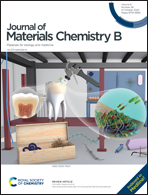A new generation of hollow polymeric microfibers produced by gas dissolution foaming†
Abstract
A new and straightforward route to produce polymeric hollow microfibers has been proposed. Polycaprolactone (PCL) hollow fibers are obtained for the first time using an environmentally friendly gas dissolution foaming approach, overcoming its limitations to induce porosity on samples in the micrometric range. Different porous morphologies are achieved from solid PCL microfibers with a well-controlled diameter obtained by conventional electrospinning. The optimization of the foaming parameters provides two sets of well-defined hollow fibers, one showing smooth surfaces and the other presenting an enhanced surface porosity. Accordingly, gas dissolution foaming proves to be not only suitable for the production of hollow polymeric microfibers, but is also capable of providing diverse porous morphologies from the same precursor, solid fibers. Moreover, a preliminary study about the suitability of this new generation of foamed hollow polymeric fibers for drug delivery is carried out, aiming to take advantage of the enhanced surface area and tunable morphology obtained by using the proposed new production method. It is found that the foamed microfibers can be loaded with up to 15 wt% of ibuprofen while preserving the morphology of each kind of fiber. Then, foamed PCL fibers presenting a hollow structure and surface porosity show a remarkable constant release of ibuprofen for almost one and a half days. In contrast, the original solid fibers do not present such behavior, releasing all the ibuprofen in about seven hours.



 Please wait while we load your content...
Please wait while we load your content...